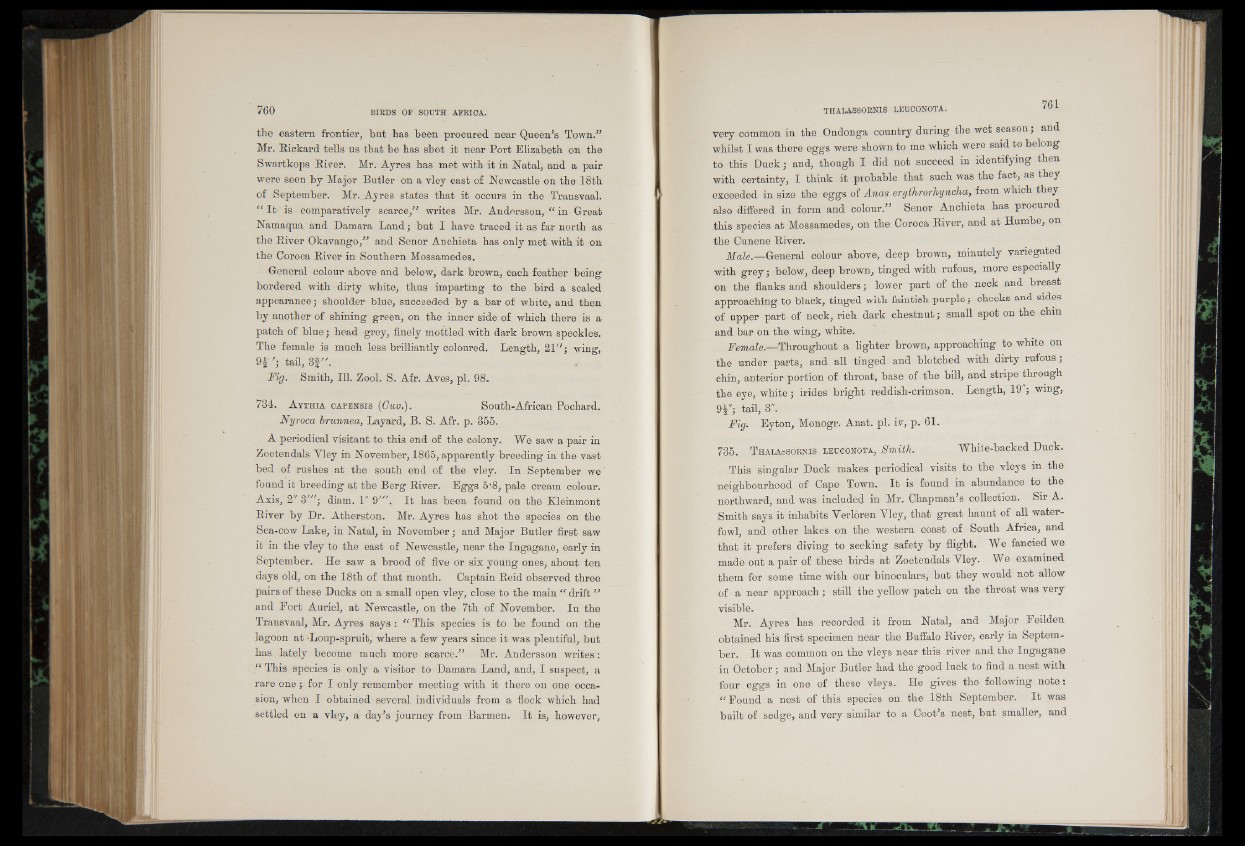
the eastern frontier, but has been procured near Queen’s Town.”
Mr. Rickard tells us that he has shot it near Port Elizabeth on the
Swartkops River. Mr. Ayres has met with it in Natal, and a pair
were seen by Major Butler on a vley east of Newcastle on the 18th
of September. Mr. Ayres states that it occurs in the Transvaal.
3 it- is comparatively scarce,” writes Mr. Andersson, “ in Great
Namaqua and Damara Land; but I have traced it as far north as
the River Okavango,” and Senor Anchieta has only met with it on
the Coroca River in Southern Mossamedes.
General colour above and below, dark brown, each feather being
bordered with dirty white, thus imparting to the bird a scaled
appearance; shoulder blue, succeeded by a bar of white, and then
by another of shining green, on the inner side of which there is a
patch of blue; head grey, finely mottled with dark brown speckles.
The female is much less brilliantly coloured. Length, 21” ; wing,
9*''; tail, 3f".
Fig. Smith, 111. Zool. S. Afr. Aves, pi. 98.
734. A y t h i a c a p e n s i s (Gu v . ) . South-African Pochard.
Nyroca brunnea, Layard, B. S. Afr. p. 355.
A periodical visitant to this end of the colony. We saw a pair in
Zoetendals Vley in November, 1865, apparently breeding in the vast
bed of rushes at the south end of the vley. In September we
found it breeding at the Berg River. Eggs 5’8, pale cream colour.
Axis, 2" 3'”; diam. 1" 9'” . I t has been found on the Kleinmont
River by Dr. Atherston. Mr. Ayres has shot the species on the
Sea-cow Lake, in Natal, in November; and Major Butler first saw
it in the vley to the east of Newcastle, near the Ingagane, early in
September. He saw a brood of five or six young ones, about ten
days old, on the 18th of that month. Captain Reid observed three
pairs of these Ducks on a small open vley, close to the main “ drift ”
and Eort Auriel, at Newcastle, on the 7th of November. In the
Transvaal, Mr. Ayres says : “ This species is to be found on the
lagoon at -Loup-spruit, where a few years since it was plentiful, but
has lately become much more scarce.” Mr. Andersson writes:
“ This species is only a visitor to Damara Land, and, I suspect, a
rare onefor I only remember meeting with it there on one occasion,
when I obtained several individuals from a flock which had
settled on a vley, a day’s journey from Barmen. It is, however,
very common in the Ondonga country during the wet season; and
whilst I was there eggs were shown to me which were said to belong
to this Duck; and, though I did not succeed in identifying then
with certainty, I think it probable that such was the fact, as they
exceeded in size the eggs of Anas erythrorhyncha, from which they
also differed in form and colour.” Senor Anchieta has procured
this species at Mossamedes, on the Coroca River, and at Humbe, on
the Cunene River.
Male.—General colour above, deep brown, minutely variegated
with grey; below, deep brown, tinged with rufous, more especially
on the flanks and shoulders; lower part of the neck and breast
approaching to black, tinged with faintish purple; cheeks and sides
of upper part of neck, rich dark chestnut; small spot on the chin
and bar on the wing, white.
LbmaZeii—Throughout a lighter brown, approaching to white on
the under parts, and all tinged and blotched with dirty rufous;
chin, anterior portion of throat, base of the bill, and stripe through
the eye, white; irides bright reddish-crimson. Length, 19"; wing,
9 |"; tail, 3".
Fig. Eyton, Monogr. Anat. pi. iv, p. 61.
735. T halassornis leuconota, Smith. White-backed Duck.
This singular Duck makes periodical visits to the vleys in the
neighbourhood of Cape Town. I t is found in abundance to the
northward, and was included in Mr. Chapman s collection. Sir A.
Smith says it inhabits Verloren Vley, that great haunt of all waterfowl,
and other lakes on the western coast of South Africa, and
that it prefers diving to seeking safety by flight. We fancied we
made out a pair of these birds at Zoetendals Vley. We examined
them for some time with our binoculars, but they would not allow
of a near approach ; still the yellow patch on the throat was very
visible.
Mr. Ayres has recorded it from Natal, and Major Feilden
obtained his first specimen near the Buffalo River, early in September.
It was common on the vleys near this river and the Ingagane
in October; and Major Butler had the good luck to find a nest with
four eggs in one of these vleys. He gives the following note:
“ Found a nest of this species on the 18th September. I t was
built of sedge, and very similar to a Coot’s nest, but smaller, and